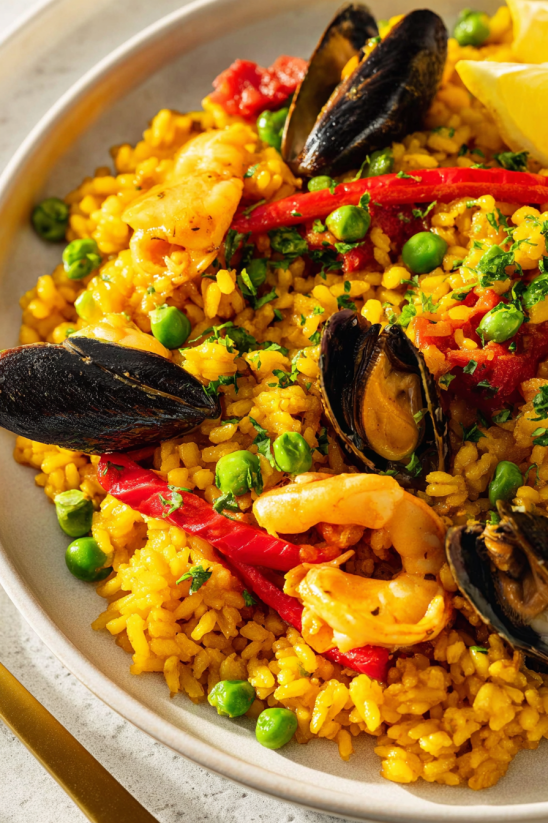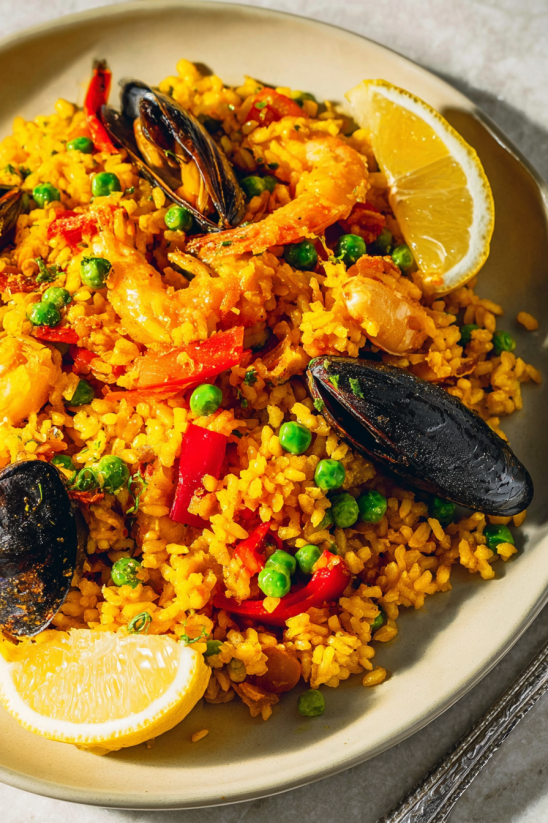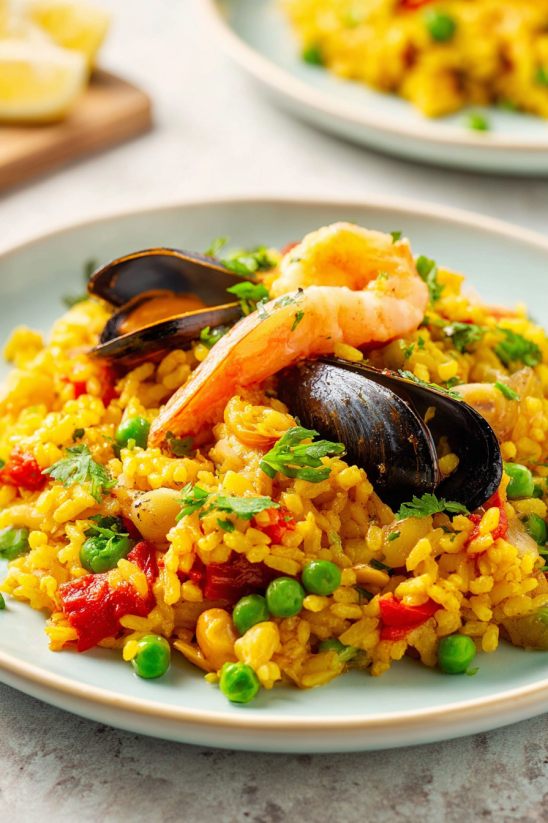 Save Pin
Save Pin
This crowd-pleasing seafood paella delivers a medley of juicy shrimp, mussels, tender rice, and fresh vegetables, all kissed with golden saffron. It is a family recipe that always feels like a celebration—whether you are feeding company or just enjoying a night in. The layers of color and flavor will make you feel like you are dining at a seaside cafe in Spain.
I first made this for my partner and me on one of our rare kid-free nights and it instantly became our go-to meal for anniversaries and celebrations. Paella never fails to bring out smiles and seconds around the table.
Ingredients
- Olive oil: Adds richness and helps sauté the vegetables Choose extra-virgin for the best flavor
- Yellow or white onion: Sweeter varieties create a balanced base Pick one that feels heavy for its size
- Garlic: Fresh cloves give the most aroma and depth
- Red bell pepper: Brings bright color and natural sweetness Look for firm shiny peppers
- Frozen peas: Add a pop of color and gentle sweetness Opt for petite peas if available
- Smoked paprika: Lends a smoky complexity Use Spanish smoked paprika
- Seafood bouillon: Concentrates seafood flavor Look for low-sodium if using store-bought
- Saffron threads: The defining flavor and color of paella Just a pinch will do Always check aroma before buying
- Seafood or vegetable stock: Provides depth and enhances the seafood Buy or make low-sodium to control seasoning
- Dry white wine: Balances the richness Pick a crisp unoaked bottle
- Spanish paella rice (Bomba or Calasparra): Absorbs lots of liquid and flavor Avoid long grain rice for texture
- Shrimp: Medium or large hold up well in cooking Choose raw and deveined for best results
- Mussels: Add briny flavor and visual appeal Fresh or pre-cooked both work
- Octopus or squid: Tender protein with a uniquely Spanish twist Ask for cleaned pieces to save time
- Fresh parsley: Brightens the dish as a final touch Go for flat-leaf
- Lemon: Gives tangy contrast and freshness Pick a juicy one
Step-by-Step Instructions
- Sauté the Base:
- Begin by heating olive oil in a wide shallow pan over medium-high heat Wait until the oil is shimmering then add chopped onion garlic and diced red bell pepper Cook for about six to eight minutes stirring frequently until the vegetables have softened and onions are translucent This is where the flavor foundation starts
- Bloom the Spices:
- Sprinkle in smoked paprika saffron threads and seafood bouillon Stir constantly for about one minute until your kitchen smells fragrant and the spices are evenly coating the vegetables The gentle heat unlocks their flavors
- Deglaze and Simmer:
- Pour in dry white wine stirring well to scrape up any browned spots from the bottom of the pan Add warm seafood or vegetable stock and bring everything to a gentle simmer Taste and adjust the seasoning as needed
- Add the Rice:
- Pour rice evenly into the pan Spread it out with a spoon so it is distributed in a thin fairly even layer Avoid stirring after this point Allow the rice to absorb the flavorful liquid and cook uncovered for about fifteen minutes
- Nestle in the Seafood and Veggies:
- Arrange shrimp mussels and octopus over the rice Scatter peas in as well Partially cover the pan with a lid or foil to trap some steam but leave a gap to prevent sogginess Cook for another ten to twelve minutes until the shrimp are pink and mussels are open
- Create the Socarrat:
- Uncover the pan Raise the heat slightly for just a minute or two Let the bottom form a golden crust It should sound crackly but not burn
- Rest then Serve:
- Take the pan off the heat Cover with a clean towel and let everything rest for five minutes Serve straight from the pan sprinkled with fresh parsley and lemon wedges on the side
 Save Pin
Save Pin
My all-time favorite part of paella is the crispy golden socarrat at the bottom of the pan Scraping it up feels like unlocking a little treasure Every time we make this at home I take a second to savor that first bite and the memories of Sunday family lunches in my childhood kitchen
Storage Tips
Paella will keep in sealed containers in the refrigerator for up to three days Reheat gently on the stovetop with a splash of extra broth to prevent the rice from drying out Seafood is at its best when eaten fresh so try to finish leftovers within a couple of days
Ingredient Substitutions
You can swap out the seafood for other proteins like chicken or chorizo if you cannot find fresh seafood Vegetarians can load up with extra bell peppers carrots and even artichoke hearts Just remember the flavor will shift a bit depending on what you choose
 Save Pin
Save Pin
Serving Suggestions
Serve paella as the centerpiece of a meal with simple sides like a crisp green salad and crunchy bread Lemon wedges on the side are a must A glass of dry Spanish white wine makes the dining experience extra special
Cultural Notes
Paella comes from Valencia Spain and is deeply tied to family gatherings and community traditions The socarrat the crispy rice layer at the bottom is considered the highlight by many Spanish cooks Each region has its own spin with different proteins and vegetables to suit what is local and fresh
Commonly Asked Questions
- → What kind of rice is best for seafood paella?
Short-grain Spanish rice like bomba or calasparra is ideal. Arborio works as an alternative for the starchy texture prized in paella.
- → Can I use different types of seafood?
Absolutely! Shrimp, mussels, octopus, squid, and even clams are popular choices. Mix and match based on your taste and availability.
- → Why use saffron in paella?
Saffron gives the rice its golden color, distinct aroma, and signature subtle flavor that defines authentic Spanish paella.
- → How do I get crispy socarrat at the bottom?
Let the paella cook uncovered with minimal stirring, and finish uncovered on high heat for 1-2 minutes to crisp the rice base.
- → What can I substitute for seafood stock?
Vegetable or chicken stock works; boost flavor with seafood or chicken bouillon if seafood stock isn't available.
- → Is paella traditionally spicy?
No, but you can add cayenne or red pepper flakes if you prefer a bit of heat in your dish.
